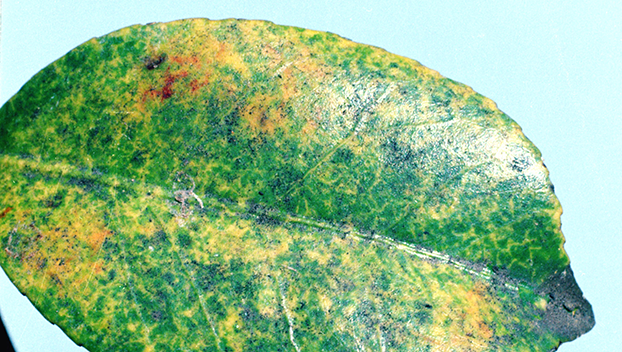Navigating spots on Camellias
Published 12:39 pm Wednesday, May 19, 2021

- TEA SCALE: This leaf comes from a C. japonica plant and shows signs of tea scale along the leaf’s outer side. (Photo courtesy of Clemson University, USDA Cooperative Extension Slide Series, Bugwood.org)
|
Getting your Trinity Audio player ready...
|
The caller noticed that her camellia leaves weren’t looking very good. There were some spots and yellowing or what we would call chlorosis. Before we look at diseases or insect pests, let’s talk about the plants and their ideal growing conditions.
Camellias are absolutely beautiful shrubs. There are two main species that we grow in our Southern gardens, Camellia sasanqua and C. japonica. Sasanqua camellias have smaller leaves and bloom from early fall into early winter. They grow 6-10 feet high and 3-5 feet wide with flowers that range in size from 2 to 3 inches in diameter. Japonicas grow much larger ranging in size from 15-20 feet tall and 6-10 feet wide. They have larger leaves and flowers that range in size from 4 to 8 inches in diameter. They typically bloom later than the Sasanqua species beginning in mid-winter through spring. Both species come in a variety of colors and tend to do well in semi-shade conditions. They like soil pH around 5.0-5.5 and well drained soils.
Make sure to plant camellias and other plants with the proper spacing to get enough airflow to dry out the leaves. This will help to lessen disease pressure on the plants. If planting as a hedge, put them on 5-6 foot centers. If using it as a foundation planting, make sure to plant at least 4 feet (6-8’ for Japonica) from the foundation to allow for maintenance and airflow. Planting on the North side of the house will ensure they do not get too much sun.
One of the big questions that come up this time of year is about Camellia leaf spots. There are several reasons why a camellia may get leaf spots. One of these that I see is leaf gall. Leaf galls are due to a fungal infection. The fungus infects new leaves and shoots causing them to become enlarged, thickended, and fleshy. The appearance is considerably abnormal and the color changes from light green to nearly white or even pink. As the disease progresses, the leaf will rupture revealing the spores of the fungus. Plants subject to leaf gall disease are rarely severely damaged. Picking the affected leaves off and destroying them will certainly lessen the severity of the disease in the upcoming season. Chemical controls are available to prevent the disease but they have a limited effectiveness against this disease.
There is a virus called Camellia yellow mottle virus that is transmitted by root grafts and propagation of diseased cuttings. This causes a really cool looking yellow design to appear on the leaves. Unfortunately, there is control for plant viruses. Your best defense against an issue like this is to buy from a reputable nursery.
Another fairly common leaf spot is algal leaf spot caused by parasitic algae. This disease has both a wide geographic range and a wide host range. There are over 200 species that can be affected by algal leaf spots from camellias to magnolias. Spots on leaves are typically blotchy and/or circular. They will be raised from the surface with wavy or feathery edges. Usually a gray-green to greenish-brown color, they will be red-brown when producing spores. Algal leaf spot can infect the branches as well causing tip die-back. When the disease is mild, remove diseased leaves and branches. When it becomes severe, chemical controls may be necessary but are often difficult on trees. On shrubs this can be a more manageable task. Use a copper fungicide (available from multiple brands) every two weeks when wet conditions exist. Copper fungicides may injure some plants, so make certain to read the label completely before applying.
The issue we have with this caller however, was armored scale, more specifically this was tea scale. Scales are insects that attach themselves to the plant leaves or stems and feed on the sap of the plant. There are two different subgroups of scales that fall into armored scales and soft scales. Soft scales are much easier to deal with and can often be washed off with a strong spray of water from a garden hose. Armored scales however are much tougher. They are most often found on the underside of the leaves. The upper portion of the infected leaf will appear to have a modelled look with chlorotic splotches. A small infestation can be worked on by removing infected leaves or stems. Larger infestations however can require a different approach. Using a systemic product that contains dinotefuran has been shown to be effective against scales but will not completely fix the issue. Other systemic products such as imidacloprid have been found to be largely ineffective on armored scales. Using horticultural oil (multiple brand names) in the dormant season will help by suffocating the scale. This requires multiple applications 7-14 days apart to be effective in the dormant season (January-February). The last tier of this approach is to scout for crawlers beginning in April. Use double-sided tape around branches and stems to trap crawlers. When you begin to see them is when to spray using an insecticide. Products that contain acephate tend to have a higher residual effect than other products.
Always read the entire label of any product that you are using before applying the product. Make certain that the pest you are trying to work on is on the label and that the product is safe for your plants. Apply according to the rates and application instructions contained on the label and follow any PPE (Personal Protective Equipment) that may be required by the label.
If you are having an issue in your home garden or landscape, send your questions to Gene Fox, Consumer Horticulture Agent with the North Carolina Cooperative Extension Service, please email Gene at gene_fox@ncsu.edu or call at (252)946-0111. You can also ask to speak to a Master Gardener. On Mondays and Wednesdays between 10 a.m. and 12 p.m., they man the Greenline to answer all of your home horticulture questions. Master Gardeners are also manning a booth at the Harbor District Market. Bring your questions and sick plants to be diagnosed by a Master Gardener.
Gene Fox is the area consumer horticulture agent with North Carolina Cooperative Extension.





